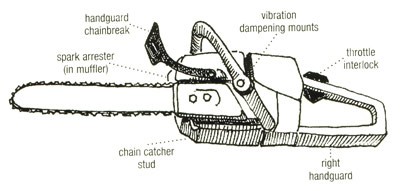Modern chainsaws are the product of 40 years of evolution. Manufacturers’ continued focus on safety and productivity has produced saws that have a number of safety features that might not be readily apparent even to a veteran cutter. Here’s a rundown on some of these features.
Vibration dampening mounts are rubber bumpers installed where the front and rear handles attach to the saw (see illustration). They reduce vibration from being conducted to the operator’s hands, where it can contribute to operator fatigue and, over time, cause serious circulation problems for the operator. Make sure these dampening mounts are present and in good condition.
The spark arrestor is a piece of screening attached to the saw’s exhaust port that is designed to prevent sparks from exiting the saw and potentially causing fires. The arrestor can become caked with carbon over time, particularly if you are running a fuel mixture with more oil than the manufacturer calls for. Make sure the arrestor hasn’t fallen off. If it’s dirty, remove the retaining screw to slide the arrestor out and clean off any carbon buildup. A saw with a clogged arrestor will behave much like a saw with a clogged air filter, and the starter cord will be more difficult to pull.
Most operators are familiar with the handguard chain brake, an inertial brake that stops the chain if the saw jerks too quickly. Clean the area around the brake inside the clutch cover frequently. Check to make sure this brake is functional by resetting it each time you start the saw. To test the inertial brake, first make sure the saw is NOT running and the brake is off. Then hold the saw level and 18 inches above a stump. Release your grip on the front handle (but not the rear handle) and allow the saw bar to pivot downward and hit the stump. The sudden stop as the bar meets the wood will engage the brake if it’s working properly. (Note: older saws may not have been equipped with inertial brakes.)
The chain catcher stud is a piece of metal or plastic, attached to the underside of the saw housing below the bar bolts. It is designed to minimize the length of broken or dismounted chain that might otherwise swing around the back of the rear handguard, injuring the operator’s right arm and elbow or leg. Make sure it is in place, and for good measure, check that your chain is tensioned properly and your bar is in good shape.
The right handguard is a wide piece of hard plastic that is often an integral part of the handle mold. It is designed to protect your hand in the case of a thrown or dismounted chain. Make sure it is not cracked or broken off.
The throttle interlock is located on the top of the rear handle and is designed to prevent the throttle from being opened unless the operator’s hand is clutching the rear handle. This may seem unimportant, but imagine that you are walking from one cut tree to another with the saw running and the brake not set.(Of course, you should always have the brake set in this situation.) Without the throttle interlock, a branch could engage the throttle at a potentially catastrophic moment. To test it, be certain the throttle cannot be depressed when the interlock is not depressed.
Of course, the most important safety equipment is a trained operator. Take a Game of Logging class if you haven’t before, and if it has been awhile, consider a refresher.


